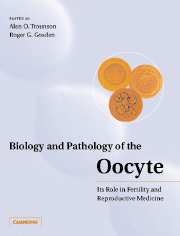1 - The magic and mystery of the oocyte: ex ovo omnia
from Part I - Historical perspective
Published online by Cambridge University Press: 05 August 2016
Summary
I hope I may be forgiven for using as the subtitle of this chapter on the history of the oocyte that prophetic quotation from the frontispiece of William Harvey's great work, De Generatione Animalium (On the Generation of Animals), first published in Latin in 1651, and in English 2 years later. The frontispiece depicts a crowned Zeus seated on his throne and holding in his hands the two halves of an egg, inscribed with the words ex ovo omnia ('everything comes from the egg’) (Figure 1.1). Emerging from the egg are plants, insects, fish, amphibians, reptiles, birds and mammals, including Harvey's beloved fallow deer, the subject of many of his researches (Figure 1.2).
Harvey was already 73 years old when he published De Generatione, although he had been sitting on the completed manuscript for some considerable time, reluctant to publish for fear of the controversy that it would arouse. Harvey had a foretaste of this following the publication of his monumental account of the circulation of the blood, De Motu Cordis, in 1628. It was Harvey's old friend, Dr George Ent, visiting him in his retirement outside London, who eventually persuaded him, somewhat reluctantly, to part with the manuscript of De Generatione, although Harvey still felt that ‘It was better to grow wise at home and in private, than to stir up storms that might destroy leisure and peacefulness’ (Keynes, 1966).
There may, however, have been a more deepseated reason for Harvey's reluctance to publish; not withstanding his dictum of ex ovo omnia, he was completely baffled by how it was that the egg came into being. As a physician to King Charles I, he was able to accompany the King in his weekly hunts offallow deer (Dama dama) and red deer (Cervus elaphus) in the Royal forests, parks and chases which were maintained for that very purpose. Since fallow and red deer are strict seasonal breeders, with the rutting season, ovulation and conception confined to a few brief weeks in the autumn, Harvey had an unrivalled opportunity to anatomize fallow does and red deer hinds during this period to see how conception actually occurred. An Aristotelian at heart, Harvey was expecting to find that the ‘seed’ of the male would coagulate the ‘menstrual blood’ of the female to form a large, spherical ‘egg’ in the lumen of the uterus.
- Type
- Chapter
- Information
- Biology and Pathology of the OocyteIts Role in Fertility and Reproductive Medicine, pp. 3 - 10Publisher: Cambridge University PressPrint publication year: 2003
- 11
- Cited by

